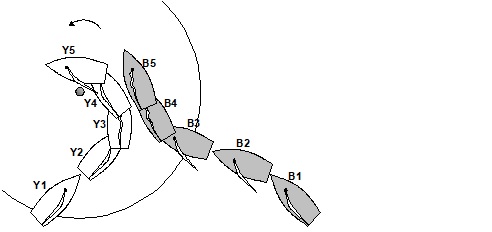


Section E - The Windward Mark
TR CALL E7
Rule 16.1, Changing Course
Rule 18.3, Passing Head to Wind in the Zone
Rule 31, Touching a Mark
Definitions, Fetching
Question
Y on port tack and B on starboard tack are approaching a port-hand windward mark.
B bears away, and as a result Y is no longer able to keep clear of B by passing astern
of her. Y passes head to wind in the zone ahead and to leeward of B and is then fetching
the mark. After Y completes her tack she passes close to the mark and B has to luff
and sails above close-hauled to avoid Y. B protests. What should the call be?

Answer 1
When B changes course, rule 16.1 requires her to give Y room to keep clear of B
including, in this situation, space for Y to comply with her obligations under rules 18.3
and 31.
If Y does not respond promptly, but would have been able to sail to the wrong side of
the mark without hitting it if she had done so, penalize Y for breaking rule 18.3.
If Y does respond promptly to the change of course by B, but is unable to tack and pass
the mark on the wrong side, then Y is entitled to space to comply with rules 18.3 and
31. B gives Y this space by luffing. No penalty.
If B had held the course she was sailing at position 1, Y would have been required to
keep clear of B and, if she tacked, to comply with rule 18.3.
When a right-of-way boat changes course and thereby creates a situation that will
cause a breach of a rule by the other boat, she breaks rule 16.1 if she maintains this
course. However, she may change course again to comply with rule 16.1, in which case
neither boat breaks a rule. See also Call B4.






